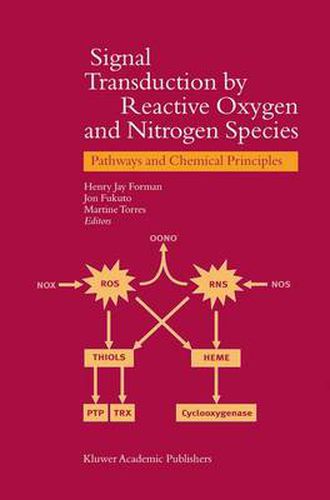Readings Newsletter
Become a Readings Member to make your shopping experience even easier.
Sign in or sign up for free!
You’re not far away from qualifying for FREE standard shipping within Australia
You’ve qualified for FREE standard shipping within Australia
The cart is loading…






This title is printed to order. This book may have been self-published. If so, we cannot guarantee the quality of the content. In the main most books will have gone through the editing process however some may not. We therefore suggest that you be aware of this before ordering this book. If in doubt check either the author or publisher’s details as we are unable to accept any returns unless they are faulty. Please contact us if you have any questions.
Since publication of the first edition of this book, (then entitled Oxidative Stress and Signal Transduction), reactive oxygen and nitrogen species (ROS/RNS) have taken centre stage in the field of signal transduction. Our understanding of the many signalling pathways that co-ordinate the cell’s response to its environment has made significant strides and evidence is now mounting that the ROS and RNS enzymatically produced by the cells are required for different aspects of the cycle of life from growth to apoptosis. The enzymes responsible for the production of ROS and RNS have been unravelled and the participation of these species in numerous signalling pathways has been documented. The next step is now to identify the targets of ROS and RNS and the mechanisms by which they alter their activity in the affected signalling pathway and significant progress has already been made. This exciting area of research will benefit from the pulling together of the work from hard-core chemists and free radical aficionados along with that of signalling enthusiasts and cell biologist devotees. This was the idea behind the conception of this new book. This text provides relevant chemistry that can be applied across signalling systems and summarizes the state of knowledge in the area of redox signalling, including controversies when they exist and future directions. ROS and RNS have been implicated in inflammation, ageing and cancer and their novel role in signal transduction may offer new clues to their participation in these processes. This volume should be of great interest to researchers involved in a large range of scientific fields from biochemistry and physiology to pharmacology.
$9.00 standard shipping within Australia
FREE standard shipping within Australia for orders over $100.00
Express & International shipping calculated at checkout
This title is printed to order. This book may have been self-published. If so, we cannot guarantee the quality of the content. In the main most books will have gone through the editing process however some may not. We therefore suggest that you be aware of this before ordering this book. If in doubt check either the author or publisher’s details as we are unable to accept any returns unless they are faulty. Please contact us if you have any questions.
Since publication of the first edition of this book, (then entitled Oxidative Stress and Signal Transduction), reactive oxygen and nitrogen species (ROS/RNS) have taken centre stage in the field of signal transduction. Our understanding of the many signalling pathways that co-ordinate the cell’s response to its environment has made significant strides and evidence is now mounting that the ROS and RNS enzymatically produced by the cells are required for different aspects of the cycle of life from growth to apoptosis. The enzymes responsible for the production of ROS and RNS have been unravelled and the participation of these species in numerous signalling pathways has been documented. The next step is now to identify the targets of ROS and RNS and the mechanisms by which they alter their activity in the affected signalling pathway and significant progress has already been made. This exciting area of research will benefit from the pulling together of the work from hard-core chemists and free radical aficionados along with that of signalling enthusiasts and cell biologist devotees. This was the idea behind the conception of this new book. This text provides relevant chemistry that can be applied across signalling systems and summarizes the state of knowledge in the area of redox signalling, including controversies when they exist and future directions. ROS and RNS have been implicated in inflammation, ageing and cancer and their novel role in signal transduction may offer new clues to their participation in these processes. This volume should be of great interest to researchers involved in a large range of scientific fields from biochemistry and physiology to pharmacology.